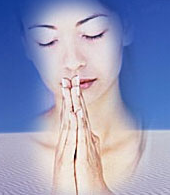 Namaste !
Namaste !
Greetings to the divine within all beings!
Yoga fine tunes the physical, elevates the emotional, and sanctifies the spiritual. It is the union of the three that brings us a heightened sense of well-being and vitality. Vitality vibrates and vibration, by nature, awakens our inner cells and all surroundings to the Divine Nature within all things.
"Our mission is to promote the overall well-being of each individual through a healthy life style and awareness of one’s inner Self."
 Philosophy
Philosophy
Yoga Inbound takes you right in to the center of your existence. As a starting point, you explore the limits of your body by the practice of body postures (Asanas), breathing exercises (Pranayama) and concentration techniques (Dhyana). Through these physical postures you will be able to relax and activate the natural healing potentials of the body which help to bring one to a state of balance and well-being.
A brief description of the Yoga Inbound system deals with the following topics:
Part I:
- Ashtanga Yoga This system of yoga has been recently introduced to the Inbound school of yoga. It was compiled by the great sage Patanjali in his classical text, the Yoga Sutras and Bhagavan Sri Krisna mention it in the Bhagavat gita. AstangaYoga consists of 8 parts (Astha; eigth, Anga: limbs )
- Yama-restraints; Yama regulates the relationship of the yogi with others. It is signified by ahimsa – non-violence, satya – truthfulness, asteya – not stealing, bramacharya – sexual restraints and aprarigraha – non-greed.
- Niyama - observances; The niyamas are saucha – cleanliness, santosa – contentment, tapas – simplicity, svadhyaya – study of the self and the ancient scriptures and isvara pranidhana – acknowledgement of a Supreme Being.
- Asana-posture; the third limb, has popularized Yoga in the west. It’s purpose is to purify the body and make it a perfect vehicle for the furthering journey. Heat is the main tool for this purification. Internal heat is generated by a continuous flow of yoga postures combined with dynamic breath. The different postures are used to direct this heat into the many different energy channels (nadis) of the body. Traditionally it is understood that you practice the 840 asanas until you can sit comfortably in the lotus position (padmasana) for a few hours.
- Pranayama-breath control; The fourth limb, It is said that who controls the breath controls the mind. It is the breath which synchronizes body and mind. There is a whole range of breathing exercises that one practices after sufficient mastery of asana is gained. Their purpose is to purify the mind. This is achieved when you can tell your mind what it should do instead of vice versa.
- Pratyahara-withdrawal of the senses; the fifth limb, means to turn the attention inward. Much of our happiness depends on wealth, pleasure, satisfaction, falling in love, etc. Pratyahara is practiced to make the yogi independent of these external stimuli. The objective is to discover the real source of happiness within us. In the asana practice for example, you are listening to your breath, gazing at specific focal points, holding the internal locks (bandhas) following the flow of postures and you become totally absorbed with what you are doing. You are directing all your energy back inside and creating a space for yourself that is completely detached from the outer world.
- Dharana-concentration, The sixth limb. Concentration in Yoga is defined as focusing the mind single-pointedly on one object. Who ever has experimented with this knows that you can maintain this for a few seconds and not much longer. Through daily asana practice, focusing on the breath and being mindful in the postures, this ability to concentrate the mind is rapidly improved.
-
Dhyana-meditation The next step, dhyana, is to remove all objects and keep the mind single pointed in the object of your worship (Isvara Pranidhana). The average man cannot meditate without adequate preparation. When you have purified body and mind and learnt to control your thoughts and senses you become more and more able to observe the divinity that is in your heart and in all that is around you. This is real meditation.
-
Samadhi-realization. The eighth limb, samadhi, is translated as absorption, bliss, realization and the highest consciousness or truth. In the school of Bhakti Yoga , Samadhi is reached when one has obtained his Nitya Sidha or his eternal loving relationship with the Supreme Being in one of the five rasas or moods.
-
Part II: Karma Yoga
-
Part III: Jnana Yoga
-
Part IV: Mantra Yoga
-
Part V: Bhakti Yoga

